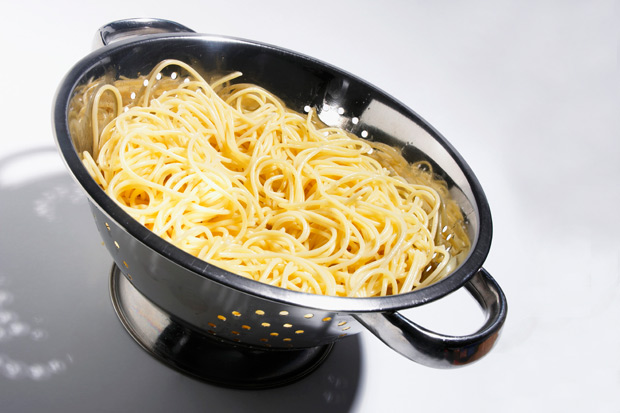 Per un italiano e per qualsiasi persona che frequenta molto l’ Italia, preparare un piatto di pasta, o pastasciutta come i è soliti chiamarla, è un qualcosa di naturale esattamente come respirare.
Per un italiano e per qualsiasi persona che frequenta molto l’ Italia, preparare un piatto di pasta, o pastasciutta come i è soliti chiamarla, è un qualcosa di naturale esattamente come respirare.
Ogni tipo di pasta ha i sui esatti tempi di cottura, normalmente stampati sulla confezione, e ogni famiglia italiana ha il suo assaggiatore che ne stabilisce la cottura al dente e quindi comunica che “si può scolare” , ovvero è venuto il momento di svuotare la pentola piena, d’acqua e pasta, nello scolapasta.

La Pasta non solo un cibo ma è anche uno dei simboli dell’Italia, tanto che per alcuni la pasta è l’Italia.
Innanzi tutto alcuni chef blasonati sostengono che la pasta non si debba cuocere, ma si deve solo reidratare.
Quindi pensare, come tutti noi facciamo che la pasta debba essere cotta è un errore concettuale. La pasta viene immersa in acqua bollente e grazie al calore da secca si ammorbidisce reidratandosi. Quindi sembra che non sia necessario che l’acqua sia in continua ebollizione per tutta la durata. Prima di “mettere la pasta in pentola”, ovvero nell’acqua bollente dobbiamo essere certi che quest’ultima sia effettivamente in ebollizione.

Quindi inseriremo la pasta solo dopo averla salata e solo dopo che l’ebollizione sia iniziata, ma passati un paio di minuti sarà possibile abbassare al minimo l’acqua se non addirittura toglierla dal fuoco come suggerisce la cottura passiva dello chef Gualtiero Marchesi.
Nella cottura passiva la pasta deve cuocere solo 2 minuti a partire dal bollore, ovvero dal momento che l’acqua ha ripreso a bollire dopo averla versata nella pentola. Quindi dovremo spegnere il fuoco e coprire la pentola con un coperchio.
Attraverso questa operazione la pasta continua la sua cottura , passivamente, fino al termine dei minuti previsti per quel tipo di pasta. Se invece la pasta bolle per tutto il tempo sul fuoco, disperderà molto amido e glutine e quindi anche sapori e nutrimenti.
Cottura al dente
Cuocere la pasta al dente significa lasciarla un poco dura o “scrocchierella”. Per far questo bisogna togliere la pasta dall’acqua al momento giusto, e questa è una tradizione italiana che si rispetta non solo per il gusto, ma anche perché quasi tutti gli italiani sanno che così risulta più digeribile rilasciando tutti i valori nutrizionali.
Acqua della pasta
L’acqua della pasta non si scola e interamente, è necessario tenerne sempre un po da parte. L’acqua della pasta tornerà spesso utile perché è ricca di sapori che impreziosiscono il sugo che potrebbe risultare troppo asciutto, e quindi si usa per allungarlo.
Quantità esatta di acqua e sale
Sappiano che è buona regola cuocere la pasta in abbondante acqua salata. Per essere certi di non sbagliare andremo ad utilizzare la regola: 1 litro d’acqua e 10 g di sale per ogni 100 g di pasta.
Spaghetti che sporgono
Quando si cuoce pasta secca lunga questa è la tipica situazione in cui ci si trova se non si spezzano gli spaghetti.  La pentola sul fuoco e la pasta lunga che per 1/3 rimane fuori dall’acqua. A volte basta una mescolata e gli spaghetti si afflosceranno nella pentola, se invece abbiamo a che fare con una pasta trafilata al bronzo di buona qualità ci vorranno almeno 2 o 3 minuti con il risultato di avere una pasta rotta mezza scotta e mezza cruda. Quindi ricordiamoci sempre si usare una pentola o una una casseruola adatta.
La pentola sul fuoco e la pasta lunga che per 1/3 rimane fuori dall’acqua. A volte basta una mescolata e gli spaghetti si afflosceranno nella pentola, se invece abbiamo a che fare con una pasta trafilata al bronzo di buona qualità ci vorranno almeno 2 o 3 minuti con il risultato di avere una pasta rotta mezza scotta e mezza cruda. Quindi ricordiamoci sempre si usare una pentola o una una casseruola adatta.
Le 10 regole d’oro dei maestri pastai per cucinare la pasta

Source: http://popchartlab.com/products/the-plethora-of-pasta-permutations
1. Utilizzare sempre acqua nella proporzione di 1 litro per ogni 100 grammi di pasta questa regola è fondamentale perché la pasta si deve reidratare molto bene.
2. Per salare l’acqua utilizzare solamente il cosi detto sale grosso da cucina nella proporzione di circa 12 grammi per litro d’acqua.
3. Aggiungere il sale grosso solo dopo che l’acqua avrà raggiunto il punto dell’ebollizione e controllare che sia sciolto perfettamente e fate attenzione ad attendere, prima di inserire la pasta, che l’acqua abbia ripreso l’ebollizione. Ricordiamo che l’acqua salata bolle a temperature più elevate e quindi raggiunge più lentamente lo stato di ebollizione.
4. Usare una pentola o una casseruola piuttosto capace con pareti alte perché la pasta dovrà cuocere galleggiando bene. Bisogna sempre inserire la pasta nell’acqua (sia fresca sia secca) in una sola volta e ricordiamo di mescolarla immediatamente così non si incollerà. La cottura sarà fatta con la pentola scoperta e con una fiamma piuttosto vivace mescolando frequentemente.
5. Per evitare che certi tipi di pasta fresca, come tagliatelle, pappardelle, spaghetti, trofie ecc., si appiccichino durante la cottura, si può aggiungere all’acqua un filo d’olio extra vergine d’oliva. Per certi tipi di pasta la cui cottura termina in forno , come lasagne, cannelloni, torte salate, timballi, pasticci ecc., bisogna mantenere la pasta abbastanza cruda, o molto al dente , e si consiglia di raffreddarla con acqua fredda prima di scolarla ricordando di riscaldare il forno con un certo anticipo.
6. Per i tempi di cottura della pasta secca bisogna attenersi sempre alle indicazioni sui tempi di cottura che sono stampati sulla confezione. Per la pasta fresca seguire le indicazioni date nelle singole ricette. E’ sempre buona norma assaggiare la pasta qualche attimo prima di scolarla. Appena la pasta avrà raggiunto il giusto punto cottura versare in pentola dell’ acqua fredda di rubinetto per arrestare immediatamente la cottura, e subito dopo scolarla.
7. Scolare la pasta al “dente” mantenendo da parte un po’ dell’acqua di cottura.
8. Scaldare sempre la zuppiera o il piatto con acqua bollente e asciugarli bene prima di versarvi la pasta, a meno che non stiate facendo un piatto di pastasciutta da servire fredda.
9. Condire la pasta con una parte del sugo e servire il rimanente, caldissimo, in salsiera e questo perché il sugo facilmente si raccoglie sul fondo della zuppiera.
10. Aggiungere eventualmente il formaggio alla fine , oppure servirlo a parte, quando la pasta avrà assorbito completamente il sugo, avendo cura di grattugiarlo solo al momento, salvo il caso in cui il formaggio è un ingrediente del sugo.
La redazione Rome Central – Italy in the world è costituita da redattori freelanc, giornalisti, fotografi, registi, medici, letterati, video-makers, supporters, poeti, scrittori, attori, cantanti e tanti amici.
RomeCentral è un Magazine completamente no-profit, chiunque scrive in questa rivista lo fa senza alcuna pressione commerciale.
NB:Nessuno all’interno di Rome Central , dai direttori ai collaboratori etc.., riceve alcun tipo di compenso.










Rome Central, magazine for residents and tourits liked this on Facebook.
Margherita Fiaccavento liked this on Facebook.